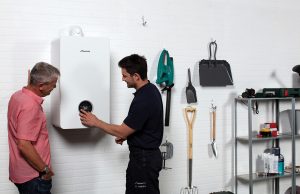
Thinking of renovating an old house for profit? This could be a decrepit property that’s long been uninhabited or just an aging house in major need of a makeover. TV shows like Sarah Beeny’s Property Ladder show how fruitful this kind of venture can be. However, while the returns of property renovation can be significant, it requires time and patience. It’s never as simple as throwing on a new coat of paint. For those at a loss about where to begin, our step-by-step guide will show you exactly what you need to do to.
Many homeowners who opt for extensive renovations, have to shift their furniture to make space for the work to be carried out. In such instances, they take help from leading experts and companies that offer house removals in london. Even if they do shift their furniture to a new house, they tend to go for the storage services that such companies offer. This helps them clear the space and secure their furniture at the same time. This is a simple, effective and great way to improve the process of renovations that might take three to six months to get completed.
- Buy the worst house in the best neighbourhood
To give yourself the best chance of making profit, opt for the worst property in the best neighbourhood. Doing so gives you the maximum potential for adding value, as the property’s run-down state will likely put most buyers off, resulting in a lower price. Whilst you can’t influence a particular neighbourhood, you can transform the house and make it befitting of its desirable location, in turn pushing up its value. Therefore, a cheap property with potential will stand you in good stead for making a profit.
Make sure to look for a property in an in-demand neighbourhood. These are usually areas that offer residents easy access to amenities like good schools, places to shop and entertainment options, and have good transport links. Once you’ve found somewhere, talk to a neighbourhood specialist to get the lowdown on the area to make sure you’re definitely looking in the right place.
When it comes to the property itself, it is imperative that you calculate roughly how much the renovation will cost and the most you’re likely to sell the property for. If the necessary changes would render it unlikely for you to make a profit, you should look elsewhere. This home improvements guide by Household Quotes gives an in-depth overview of just how much different improvements are likely to cost, and can help you work out an overall renovation estimate. Looking online at the prices of similar houses in the area will give you an idea of your property’s ‘ceiling value’—a maximum value it can achieve.
- Completely empty the house
The first step to take once you’ve acquired the house is to completely empty it. If you are buying a house that has been vacant for some time, there could still be all kinds of junk inside. Unlike when you buy directly from somebody and there is a legal vacant possession obligation stipulating that only agreed items will remain in the property, there is no such obligation with empty properties. Consequently, there could be furniture, rubbish and various other items still there. So in order to get the property in the best state possible, getting rid of any such clutter is a must.
Therefore, look around for any items left behind, keeping anything salvageable and removing everything that is not worth keeping. You can either remove these items yourself, or depending on the number of items, enlist the help of a removals company. Many removals companies, such as Clearance Solutions, will even donate or recycle any unwanted belongings as part of their house clearance service, ensuring that no goods go to waste.
- Get the essentials sorted
Whilst it’s tempting to spend your budget on decorative features, a valuer will look past these superficial factors and instead look straight at the property’s structural fittings. It’s imperative that you focus on getting all of the essentials sorted, especially if you’re buying a house in a state of disrepair.
Be prepared for the property’s central heating system to either be majorly out-of-date, or simply non-existent. Fortunately, installing or upgrading a property’s central heating will always add more value to it than it costs. In fact, according to a study from GoCompare, central heating (alongside a new boiler and double glazing) can increase a property’s value by 4%, which works out as substantially more than what you’d pay for the improvements themselves. You should also think about sealing any draughts around doors and windows, installing radiators, insulating the loft space and even installing underfloor heating.
You’ll also need to make changes like rewiring the electrics (including a PAT test on electrical compliances to ensure they’re safe to use), upgrading home security, and making the property free of damp. It is also advisable to fix any other obvious defects, like loose tiles, peeling paint, damaged windows and cracks to ceilings, as this will help you to sell the property at its optimum price.
- Remodel the property
While you’re sorting out basics of the property, it’s important to make sure you’re getting the most from the space you have by remodelling it. Perhaps the best way to achieve this is to convert a loft, basement or garage into additional living space. Whilst these conversions can be costly at the time, they have been proven to pay dividends for property owners. Research shows that loft conversions can add up to £100,000 in value to a property, which is far more than the conversion itself would likely cost. The decision to convert rooms into living space is therefore a no-brainer for many property buyers.
Other measures you can take to remodel the property include adding extra space at the bottom of the garden, altering the layout and installing new windows. However, be wary of the property’s ‘ceiling value’, and don’t just keep on blindly adding space. Make sure to thoroughly think through every major remodelling decision, or you could end up spending money you’ll never get back.
- Give the exterior a makeover
Finally, make sure you don’t neglect the property’s exterior, as the outside can make a huge difference to its value. According to research by Dulux Weathershield, increased kerb appeal can boost a property’s value by up to £55,000, and there are so many different ways you can go about making these improvements. For instance, simple measures like fresh paintwork, replacing rainwater goods and having a well-kept front garden and windows can make a huge difference. More elaborate improvements like adding a porch, installing gates and fences, and having stylish lighting can also drive up your property’s value for minimal outlay.













